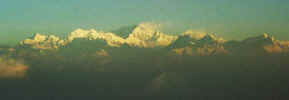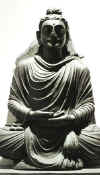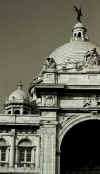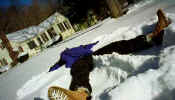Tea Town
Wednesday 26 January –
Saturday 29 January 2000
After two days of relaxation, we
were back on the road again, this time heading to Patna (again by train) where
we were due to make an overnight connection to Siliguri, near Darjeeling.
Pippa was always keen to hook up with her roots and hill stations created
and used by the British during colonial times had become one of her personal
favorites. Not to mention, of
course, the thought of a good cup of proper tea.
The overnight train to
Darjeeling was bearable, but far from comfortable.
We had bunks on which to sleep but rather than a compartment with a
lockable door (we should be so lucky), there was simply a curtain separating the
four inhabitants of our 'cabin' from anyone and everyone who chose to walk
through the main carriage, pushing the curtain aside and staring in as they did
so. We had been warned about bags
disappearing and so took major precautions to chain everything to the bunk using
all the padlocks we had. Our money
and passports were secured on our person. In
fact, everything was grounded … except for our boots.
The next morning, Eric was shoeless.
Luckily, he had a pair of
open-toed sandals which, given the cold weather, had not seen much use since our
arrival in India.
From Siligiri, we travelled by
jeep up the winding hillside to Darjeeling.
Once we were out of town, we were in green, open countryside and began
the uphill climb, passing several tea plantations as the climate began to grow
steadily colder and a thick mist began to settle around us.
Parallel to the road, tiny railway tracks ran, occasionally crossing the
road. They looked as if they had
been made for a mini-sized train and indeed there were the tracks for the toy
train, which for generations has been making the steep ascent into the mountains
from the plains, often washed out by monsoon rains and out of service but now a
major tourist attraction.
When the British arrived in
Darjeeling it was almost completely forested and virtually uninhabited.
It was first established as an R&R centre for their troops, but soon
people made the journey to escape the heat and humidity down on the plain.
Nowadays, it was a busy town and people from all over the eastern Himalaya came
there to work or trade in addition to the many Tibetan refugees who
arrived in search of a new life. Darjeeling’s
most famous export is tea and it produces almost a
quarter of all India’s production, employing some 40,000 people.
Our visit to Darjeeling was out
of season but despite this, the place was buzzing with activity.
We had come simply to relax for a few days and although we knew it would
be cold, little did we know we would be taking hot water bottles to bed with us
and in need of thermal underwear! Our
hotel, the Grande Dame of Darjeeling, would probably have been an exquisite place to
stay during the summer when you could sit out in the pleasant garden and enjoy a
decent cup of tea, but at this time of year it was freezing and we sat in our
room huddled around an electric fire watching our breath condense.

The highlight, however, was the
stunning views we were afforded of the Himalaya range on top of Observatory
Hill, a viewpoint sacred to both Hindus and Buddhists.
Watching the sunrise over these snowy peaks was breathtaking and we began
to appreciate the love that climbers feel for these majestic
peaks. We could see Mount Everest
way in the distance as well as the closer Mount Kanchenjung, the world’s third
highest mountain.
Whilst in Darjeeling, we faced
the decision as to where we would head next.
We had three weeks remaining before we needed to be back in Bangkok to
take our flight home and had yet to even touch the southern part of this
incredible country. We realised
that time would be tight even if we were to fly, using an internal air pass that
could parachute us in to the key cities we wanted to explore.
But this wouldn’t give us time to spend much time on the ground and do
justice to these extraordinary places. In
addition, we were beginning to tire of arduous travel and Pippa especially was
finding it difficult to keep up with our aggressive pace in between heavy bouts
of morning sickness.
And so we took the decision to
return home early, leaving southern India for another time.
We would be sad to leave, but knew we would be back again one day to see
what we had left behind. We booked tickets to Calcutta, giving ourselves two
days to see the sights there before heading back to Bangkok on the final leg
home.
Calcutta
Sunday 30 January - Monday
31 January 2000
 Unlike Delhi, Calcutta is a
relatively recent creation, dating back a mere 300 years to the times of the
British. Now it was more famous
for its slums and squalor than any monuments and like many Indian cities is
chaotic and run down.
Unlike Delhi, Calcutta is a
relatively recent creation, dating back a mere 300 years to the times of the
British. Now it was more famous
for its slums and squalor than any monuments and like many Indian cities is
chaotic and run down.
 Our tour of Calcutta took us to
the Indian Museum, housed in an impressive colonial building with a beautiful façade
as well as the Victoria Memorial with its Calcutta Gallery, but there were many,
many more sights on offer throughout this bustling city.
We then motivated ourselves to visit the Victoria Memorial, a huge white marble museum which houses a grand
collection of memorabilia from the days of the British Empire.
Our tour of Calcutta took us to
the Indian Museum, housed in an impressive colonial building with a beautiful façade
as well as the Victoria Memorial with its Calcutta Gallery, but there were many,
many more sights on offer throughout this bustling city.
We then motivated ourselves to visit the Victoria Memorial, a huge white marble museum which houses a grand
collection of memorabilia from the days of the British Empire.
It was an interesting place to wander, amid the hoards of locals, but
after so many temples, monuments and museums we had seen on our trip across Asia
so far, we were travel-weary and found our thoughts turning more and more to
home. In just a few days, there we were, relishing 50 cm (18 inches) of snow in
the backyard and thrilled to death to have all the comforts we'd missed for
nearly half a year.

After a month's recovery and
preparation, our next trip would be to Oceania...